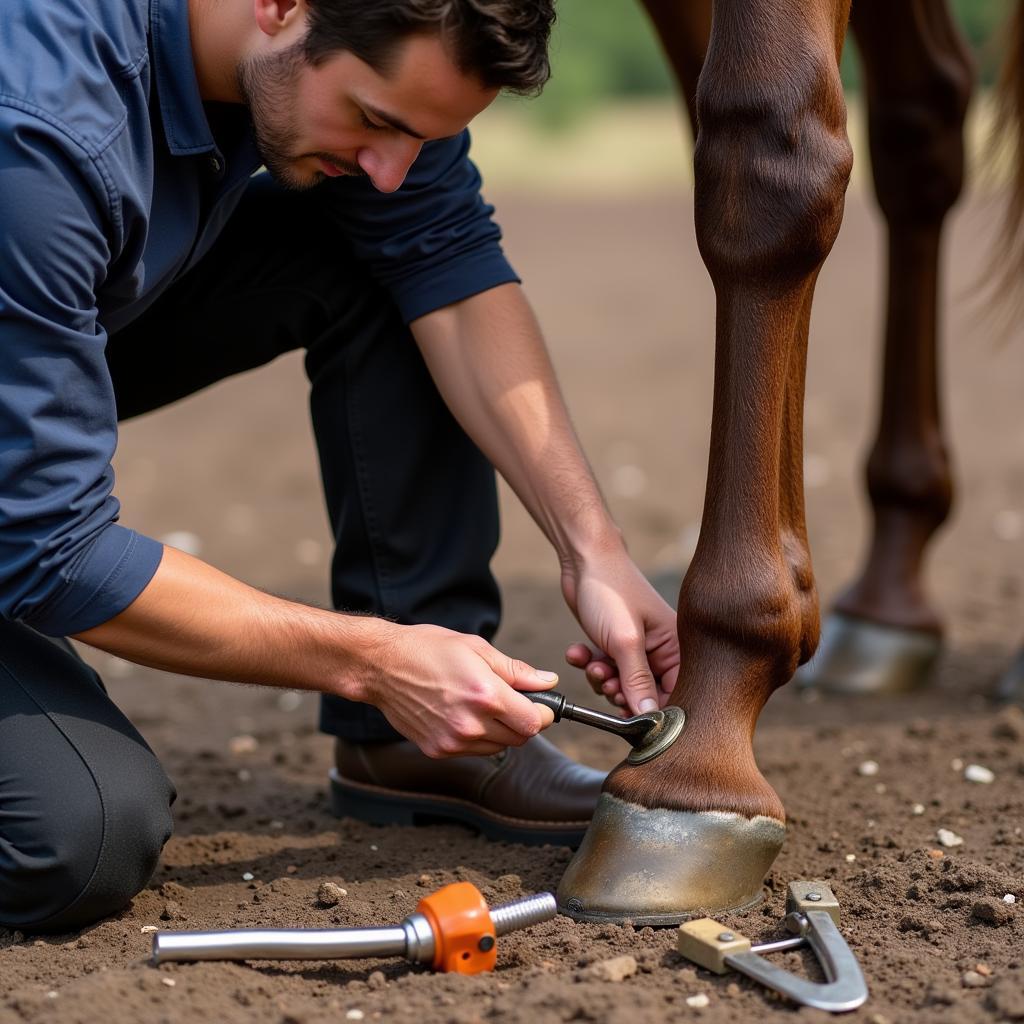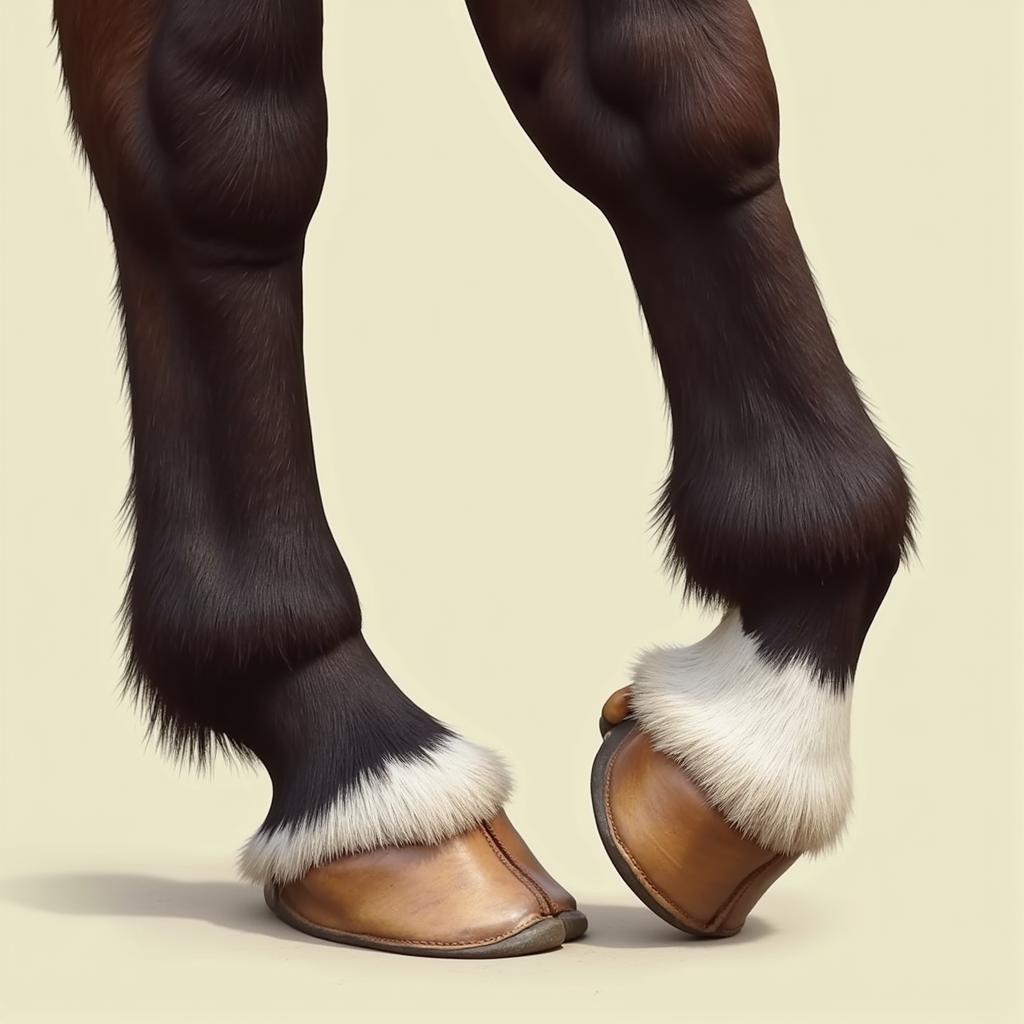Trimming your horse’s hooves is a crucial aspect of their overall health and well-being. Proper trims ensure correct balance, prevent lameness, and support your horse’s performance. This comprehensive guide will cover everything you need to know about trims for horses, from understanding the anatomy of the hoof to choosing the right farrier.
Why are Trims for Horses so Important?
Regular trims for horses are as important as regular dental checkups for humans. Overgrown hooves can lead to a variety of problems, including imbalances, cracks, and abscesses. These issues can cause pain, lameness, and even long-term damage. Trimming helps maintain the hoof’s natural shape and function, allowing your horse to move comfortably and perform at their best.
How Often Should a Horse’s Hooves be Trimmed?
Most horses require a trim every 6-8 weeks, although some may need more frequent attention depending on their individual needs and hoof growth rate. Factors such as breed, environment, and workload can influence how quickly a horse’s hooves grow. Consult with a qualified farrier to determine the ideal trimming schedule for your horse. Just like choosing the best hoof supplement for horses, a regular trimming schedule is crucial for maintaining healthy hooves.
Recognizing When Your Horse Needs a Trim
While a regular schedule is important, sometimes your horse may need a trim sooner than expected. Look for signs such as overgrown hoof walls, chipped or cracked hooves, and changes in your horse’s gait. If you notice any of these signs, it’s time to contact your farrier.
Choosing the Right Farrier for Your Horse
Selecting a qualified and experienced farrier is essential for your horse’s hoof health. A good farrier will have a deep understanding of equine anatomy and biomechanics. They will also be able to assess your horse’s individual needs and create a trimming plan that promotes optimal hoof health. Don’t hesitate to ask for recommendations from fellow horse owners or your veterinarian.
 Qualified Farrier Trimming Hooves
Qualified Farrier Trimming Hooves
Different Types of Trims for Horses
There are various types of trims for horses, each designed to address specific needs or disciplines. Some common types include:
- Natural Trim: This method focuses on mimicking the natural wear patterns of wild horses.
- Performance Trim: Tailored to the specific demands of a horse’s discipline, such as jumping or dressage.
- Corrective Trim: Used to address hoof imbalances and promote healthy growth.
- Therapeutic Trim: Employed to treat specific hoof conditions or injuries.
Understanding the Anatomy of the Horse’s Hoof
A basic understanding of hoof anatomy is helpful when discussing trims for horses with your farrier. The hoof is a complex structure composed of the wall, sole, frog, and bars. Each part plays a vital role in the hoof’s overall function and health. Knowing the parts of the hoof allows you to better understand the trimming process and communicate effectively with your farrier. You might also want to learn about things you need for horses to ensure your horse’s overall well-being.
Common Hoof Problems and How Trims Can Help
Various hoof problems can affect horses, from minor cracks to serious abscesses. Regular and proper trims can help prevent many of these issues. Corrective trims can address existing problems and promote healthy hoof growth. If you notice your horse showing signs of lameness or hoof problems consider reading more about the best electrolytes for horses.
 Healthy Horse Hoof After Trim
Healthy Horse Hoof After Trim
“A proper trim is an investment in your horse’s long-term health and soundness,” says renowned farrier, Sarah Miller. “It’s not just about aesthetics, it’s about ensuring your horse can move comfortably and perform at its best.”
Conclusion
Regular trims for horses are essential for maintaining their hoof health, preventing lameness, and supporting optimal performance. Choosing a qualified farrier, understanding the different types of trims, and knowing the basics of hoof anatomy are crucial aspects of responsible horse ownership. By prioritizing hoof care, you are investing in your horse’s overall well-being and ensuring they can enjoy a long and active life. Keeping your horse in optimal health is also related to proper hoof care, such as the use of neatsfoot oil for horses hooves. Remember, regular trims for horses are a cornerstone of equine health.
FAQ
- What are the signs of an overgrown hoof?
- How can I find a qualified farrier in my area?
- What is the difference between a natural trim and a performance trim?
- How can I tell if my horse is experiencing hoof pain?
- What are some common hoof problems that can be addressed with corrective trimming?
- Can I trim my horse’s hooves myself?
- What should I expect during a farrier visit?
Common Situations and Questions
- Scenario: My horse is stumbling more frequently. Question: Could this be related to their hooves and needing a trim?
- Scenario: My horse’s hooves are cracking. Question: What type of trim would be best to address this?
- Scenario: I’m considering transitioning to barefoot trimming. Question: What are the pros and cons?
Further Reading and Resources
- You might also be interested in learning about shoeing stocks for horses.
Contact Us
For assistance or to schedule an appointment, contact us at Phone: 0772127271, Email: [email protected] or visit our address: QGM2+WX2, Vị Trung, Vị Thuỷ, Hậu Giang, Việt Nam. We have a 24/7 customer service team.